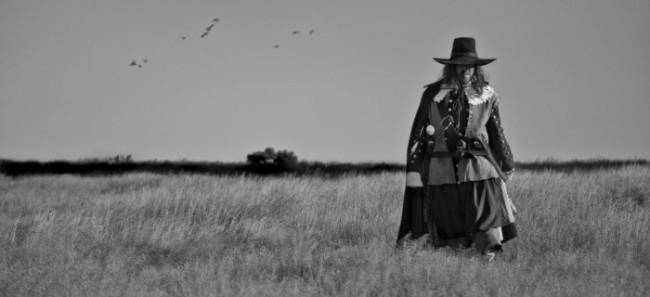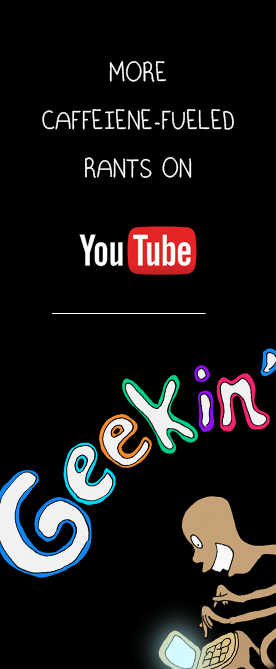By Mikhail Karadimov March 23rd, 2014
A Field in England
dir. by Ben Wheatley
A Field in England rings with that underdog, Cassavetes-like verve you’d see in an angrier, more revved-up filmmaker’s work—something akin to the ire of a younger Darren Aronofsky or Martin Scorsese, the latter of whom generously lent his name to the film’s long list of positive blurbs. It’s a scrappy dog of a picture that has no qualms with throwing everything at you, including the kitchen sink.
Delirium strikes quick and early—and bombastically—as the ground beyond us spits and explodes plumes of heaven-bound earth—shots reminiscent of Kubrick’s trench warfare scenes in Paths of Glory, an homage reinforced by the film’s stark use of black & white photography. The film’s set in the 17th-century during England’s Civil War. Due to that aforementioned budget, we find ourselves burrowed beside a length of wild hedge that cuts off our view of the ensuing pandemonium on the other side. It’s here we’re introduced to a group of English deserters who want no part in the government-legitimized suicide. The ragtag assemblage consists of your typical morality tale players: the coward, the buffoon, the dolt—all of whom function as allegorical stand-ins to a greater meaning that may or may not be there—which is often a problem with Wheatley’s scripts.
Are the philosophical and narrative threads left there to dangle in order to intrigue and compel us toward further analysis? Or is the film as unconcerned with tidiness as its slipshod manufacturing suggests?
Better yet: does it even matter?
In this case, it doesn’t.
The four stragglers march out onto the titular field—an odd choice for a bunch of deserters on the lam—in search of a much discussed alehouse, where the drinks are tall and the ladies all kinds of sordid, when they stumble upon a growth of mushrooms. Very special mushrooms. The hallucinogenic kind. Up until this point there’s very little plot. Be forewarned: plot holds very little water in Wheatley’s film. The plot acts no more than a rabbit hole for everyone—including ourselves—to plunge into.
The film lacks any and all coherence, be it narratively, structurally, or even verbally. The dialogue is sometimes difficult to make out as it dips in and out of colloquialisms to fit the errant “fuck” in—you know, for those stray moments of levity. The film is buried in grime; it isn’t shy about shoving our faces into things as sullied as one of its characters’ venereal-stricken penis, or a fish-eyed close up of a man’s face as he gorges himself on mushrooms that spill and ooze out of his bearded, sweaty mouth. No matter what the desired effect may be—to make us laugh, cringe, wince in pain—the film elicits its reactions by implementing Brechtian-levels of alienation. Director Ben Wheatley does everything he can to offend mainstream sensibilities, including several inclusions of Brueghel-like tableaux in which the actors flinch and twitch their way through eerily composed pastoral frames. Like an overenthusiastic film kid hot off the idea of shooting his first feature, Wheatley stuffs every minute of his film with technique. What could have easily turned into a gaudy display of knowledge—which the film still sometimes does—instead plays off like a hallucinogenic fever dream that refuses to quit clawing for the guts.
The film truly unleashes its gonzo side once Wheatley’s muse, Michael Smiley (The Kill List, World’s End), shows up as O’Neill, the satanic alchemist who forces our merry wanderers into locating a chest of buried treasure. O’Neill’s face hangs as one big droop, like it were made of melted wax. His nose, his cheeks, his eyes, they hang so heavy upon his forlorn mien that you start to wonder if the melancholy is too heavy to bear—to lift with a smile, a wink, an eyebrow twitch. Being evil can be oppressive in its own way. Just imagine having Beelzebub for a boss. Upon explaining his designs, O’Neill’s confronted by the group’s resident wet blanket—the coward Whitehead (Reece Shearsmith), a true believer of science and the ways of the cosmos—who he puts into line with an exceptionally strange, and unsettling, sequence of haunting imagination. O’Neill leads Whitehead into his canvass tent and shuts the flap behind him as the rest of the gang waits outside. What hits your nerves first is the high-pitched scream that bursts forth from the tent. It carries on and on as the others listen close by—rendered helpless by the gun trained on them by the turncoat Cutler (Ryan Pope). Wheatley holds the shrill up and downs of Whiteheads pains long enough for our imagination to get the worst of us. What can O’Neill possibly be doing to needle out such ungodly sounds? Certainly, it’s much worse than anything Wheatley can show us.
Or is it?
What follows, as the tent opens to reveal a staggering Whitehead—his lips curdled with demonic grin, eyes rolled white, hands gnarled with rigor mortis—is quite possibly one of the most startling and hypnotic images I’ve ever seen. In fact, the scene blistered so indelibly upon my psyche that I never quite recovered. After that, the film’s pace goes jittery, not at all fluid or as well-constructed as the scenes before it. Unfortunately, the high-level weirdness of Whitehead’s possession goes unfulfilled as the film desperately scrambles about in its remaining time to find something—anything!—to top it. Flashes of brilliance still crop up, but intermittently so.
Overall, the film is amateurishly made. Not in its technique or execution, but rather in its unbridled energy to prove that it’s a film of grave importance, made by real filmmakers and real actors with a real sense of voice. The film doesn’t lack in voice, that’s for sure. If anything it has too much of a voice—too loud, too belligerent, as if to say, “I AM WHEATLEY! I HAVE ARRIVED! COME HONOR ME AND MY DIRECTOR’S EYE!” It’s an enthusiastically made film—that’s for sure—and in lesser hands it could have been more obvious and more impressed with its cross-genre hook; but instead, the film tantalizes us with just enough braggadocio that we’re enamored by the imperfectly added flourishes of slow-motion and 2001-inspired psychedelia. Both the cast and crew clearly had a good time moseying about some field in England shooting their low budget indie, like kids in a sandbox. It shows. Everyone here is committed, from top to bottom, and that may be due in part to the seclusion of their production. I bet more than anything that all filmmakers dream of running off to some untouched part of land and filming on end with no external forces trampling down upon them. It adds a layer of creativity, of reality, and, of course, inspiration. Untouched by the outside realm, the performances—more than anything else—is what saves this film from its own over-the-topness. Despite the use of archaic dialect and period clothing—both of which are inherently silly things to deal with—the actors play the film’s absurdity perfectly straight.
Even though most of the film’s foibles work inversely for it by adding a level of quaintness to the proceedings, its ending can be considered a genuine oversight. The film should have ended five minutes sooner, once the grave’s buried and pat, as Whitehead walks over rolls of field, a grim silhouette cut out of the glow of undulating grass, forever transformed by the evil that’s shaped him. Instead of punctuating the film with a fine, but justifiably ambiguous point, Wheatley brings Whitehead back to the war where he sheds himself of all his weapons, of his momentary flirtation with violence, and trounces back across the hedge and into the smoke-hewn melee of battle—again the pacifist. Waiting across the divide for Whitehead is—of course—something more finite, the ultimate ending: another metaphorical tableau in which his former compatriots anticipate his arrival in what can only be interpreted as the afterlife.
It’s a terrible point to make, but Wheatley seems to suggest there is no war worse than the one that carries on inside our heads. And that’s exactly where Wheatley loses me. Internal struggles are difficult—to say the least—but I doubt it’s ever as horrifying as what Wheatley chose to blind us from when he cordoned off our sights with all that hedge. Understandably, the budget was low so the hedge went up to curtail any kind of talk of financing for extras and special effects, but still, even if he had the money and resources, would Wheatley even understand enough about war to show us the horror that loomed beyond his hedge?
I have my doubts.
Wheatley’s still got some growing to do. He has too much of the cult filmmaker in him. For Wheatly, the line between crucial and cool is all too murky. Wheatley’s too involved in hooks and gimmickry to discern what’s necessary and what’s not. He’s the type of director who likes to show just how much sweat and blood he’s sacrificed over the craft of his film. It’s fine and dandy if you’re the type of filmmaker who prefers to languish about as a director’s director, more involved with technique and proficiency than coherence, but I don’t think that’s what Wheatley wants.






